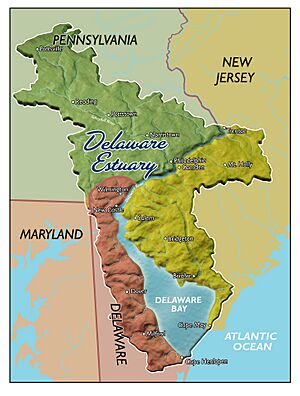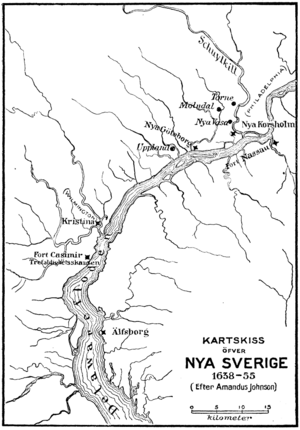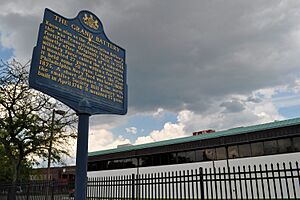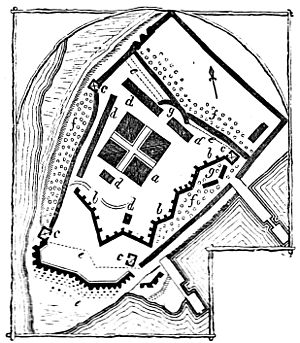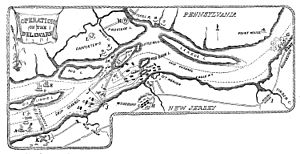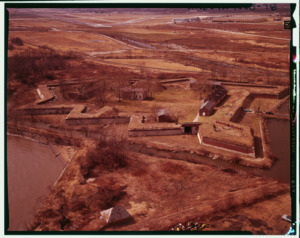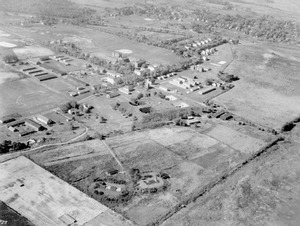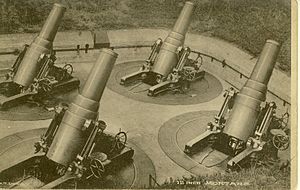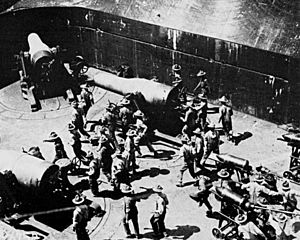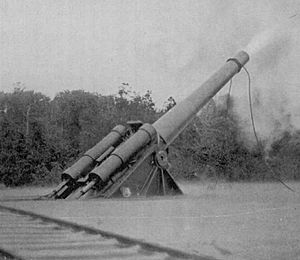Harbor Defenses of the Delaware facts for kids
Quick facts for kids Harbor Defenses of the Delaware |
|
|---|---|
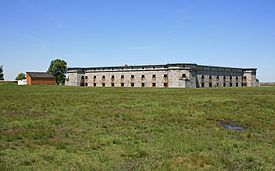
Fort Delaware on Pea Patch Island
|
|
| Active | 1896–1950 |
| Country | |
| Branch | United States Army Coast Artillery Corps |
| Type | Coast artillery |
| Role | Harbor Defense Command |
| Part of |
|
| Garrison/HQ |
|
| Mascot(s) | Oozlefinch |
The Harbor Defenses of the Delaware was a special military group. It was part of the United States Army Coast Artillery Corps. Their job was to protect the Delaware River from 1897 to 1950. They used big guns and underwater mines.
These defenses kept cities like Philadelphia, Camden, and Wilmington safe. They also protected the Chesapeake & Delaware Canal. The first forts were near Fort Delaware on Pea Patch Island. Later, during World War II, the main defenses moved to Fort Miles at the mouth of the Delaware Bay.
Contents
Protecting the Delaware River
Early Forts and Battles
First Settlements and Defenses
Europeans arrived in the Delaware Valley in the early 1600s. The Dutch built Fort Nassau in 1623. It was a trading post on the Delaware River. They saw the whole area as part of their New Netherland colony.
In 1638, Swedish and Finnish settlers started New Sweden. They built Fort Christina (now Wilmington, Delaware). The Dutch took control of New Sweden in 1655. Then, in 1664, the English took over the Dutch colony.
In 1682, William Penn founded Philadelphia. Many of his colonists were Quakers. They were peaceful and did not build forts at first. But in the 1740s, French and Spanish ships threatened Philadelphia.
During King George's War, Benjamin Franklin helped create a militia. This group built earth defenses and bought cannons. The largest was the "Association Battery" with 50 guns. After the war, these defenses were left to fall apart.
Later, in the 1750s, during the French and Indian War, plans for a fort on Mud Island were made. This island is where Fort Mifflin is today. Construction started in 1771 but stopped a year later. Only some walls were built.
The American Revolution
The American Revolutionary War began in 1775. Philadelphia leaders decided to block British ships from the Delaware River. They built three forts: Fort Billingsport, Fort Mifflin, and Fort Mercer. They also placed underwater obstacles called chevaux de frise.
In 1777, the British captured Philadelphia. But the forts and obstacles blocked their supply route on the river. The British attacked Fort Mifflin and Fort Mercer. They lost many soldiers and ships trying to take Fort Mercer.
The British then heavily attacked Fort Mifflin. After five days of bombing, the American soldiers had to leave. Fort Mifflin was almost completely destroyed. Soon after, Fort Mercer was also abandoned.
Meanwhile, the Americans won a big battle at Saratoga. This convinced France to join the war on the American side. This changed the war's direction. The British had to leave Philadelphia in 1778. The war then shifted to the southern colonies. The American victory at Yorktown in 1781 led to independence.
After the Revolution and War of 1812
After the Revolution, Fort Mifflin was rebuilt starting in 1793. Pierre Charles L'Enfant, who planned Washington, D.C., helped with the design. The fort was named after Thomas Mifflin, Pennsylvania's first governor. It was rebuilt to hold 48 cannons.
During the War of 1812, efforts were made to fortify Pea Patch Island. This island later became the site of Fort Delaware. The goal was to build defenses further down the river. This was because cannons could shoot further now. A seawall and dykes were built on the island. An earth fort was also built there during the war.
Building Stronger Forts (1815-1860)
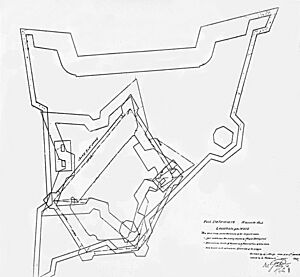
In 1815, the first Fort Delaware was designed for Pea Patch Island. It was shaped like a five-pointed star. Building it was difficult because the island was marshy. The fort was damaged by a fire in 1831.
A new, larger fort was planned, but legal issues stopped its construction for over ten years. Finally, the current Fort Delaware was built mostly between 1848 and 1860. It was designed by Joseph G. Totten.
This fort was an irregular five-sided shape. It had five small bastions, which are pointy parts for defense. It could hold 123 heavy cannons facing the water. It also had a moat around it for extra protection.
Civil War and New Ideas
Fort Delaware became a prisoner-of-war camp during the American Civil War. It held many Confederate soldiers. About 2,500 prisoners died there, many from a smallpox outbreak in 1863.
The Civil War showed that old stone forts could be easily damaged by new, powerful cannons. So, new earth forts were built in the 1870s. These included the Twenty Gun Battery near Fort Delaware and the Battery at Finn's Point. This later became Fort Mott. These new forts were designed for heavy guns and mortars. In 1876, an underground room was built near the Twenty Gun Battery to control an underwater minefield.
Modernizing Defenses
The Endicott Plan
In 1885, a group called the Board of Fortifications suggested new defenses. Their ideas were used, and construction began in 1896. New batteries and minefields were built to protect the Delaware.
Fort Delaware was updated with new gun batteries. Fort Mott was built to defend from both sea and land attacks. Fort DuPont got new gun batteries, including one with 16 mortars. These three forts became the main "Coast Defenses of the Delaware."
At Fort Delaware, three large 12-inch guns were placed inside the stone fort. These guns used "disappearing carriages." This meant the gun would pop up to fire, then lower down behind a wall to be reloaded. This kept the gun hidden and safe. Smaller 3-inch guns protected the minefields.
Fort DuPont had sixteen 12-inch mortars. These were arranged in a special way for powerful, focused fire. It also had 12-inch and 8-inch guns. Fort Mott had 12-inch and 10-inch disappearing guns. It also had 5-inch guns that could turn all the way around to fire in any direction. This was unusual for the time.
Some weapons were moved from these forts even before World War I. For example, some guns went to Hawaii. This was done to arm other important defenses.
World Wars and Beyond
World War I Changes
When America entered World War I, many changes happened. The Coast Artillery was the only part of the Army with experience using big guns. So, they were chosen to operate most of the heavy artillery in the war.
Many soldiers from the Delaware forts were sent to fight in France. Some big guns were also removed from the forts. For example, 5-inch and 6-inch guns were put on wheels to be used as field guns. Some 12-inch mortars were also moved.
In 1917–1918, many weapons were taken away from the Delaware defenses. Only a few were returned later. The 4.7-inch guns at Fort Delaware were sent to San Francisco for troop transport ships. They came back in 1919 but were soon removed and used as war memorials. An anti-aircraft battery was built at Fort DuPont in 1918.
Between the Big Wars
In 1920, Fort Saulsbury was finished near Slaughter Beach. It had 12-inch guns on "long-range barbette carriages." These carriages made the guns shoot much further. This new fort largely took over the job of the older, heavier weapons.
After World War I, many older weapon types were removed. This meant the 5-inch and 3-inch guns were taken out of service. The forts were mostly in "caretaker status" between the wars. This means only a small group of soldiers looked after them.
World War II Defenses
During World War II, many temporary buildings were put up at the forts. More soldiers were brought in. In 1940–41, the 21st Coast Artillery Regiment was sent to Fort DuPont. Mobile 155 mm guns were placed at Fort Miles and Cape May.
In 1940, Fort Delaware's three 12-inch guns were removed. Two went to Puerto Rico, and one went to a factory. In 1941, Fort Mott's 10-inch guns were sent to Canada to help with their defenses.
After the attack on Pearl Harbor in December 1941, building up Fort Miles became very important. It was at the mouth of the Delaware Bay. By 1942, concrete platforms called "Panama mounts" were built for the 155 mm guns. Eight-inch railway guns also arrived.
The Army decided to replace most old heavy guns with new 16-inch guns. At Fort Miles, two huge 16-inch guns were installed in 1942–43. These guns were protected by strong concrete bunkers called "casemates." This made them safe from air attacks. These new guns at Fort Miles made all the other heavy weapons in the Delaware defenses less important. Two 12-inch guns from Fort Saulsbury were also moved to Fort Miles.
New 6-inch gun batteries were also added. These had strong concrete bunkers for ammunition. Three "Anti-Motor Torpedo Boat" (AMTB) batteries were built with 90 mm guns. These guns could shoot at both boats and planes.
The U.S. Navy also helped protect the Delaware. They used nets and a defensive boom at Reedy Island. They also used special underwater sensors to detect submarines.
As Fort Miles' batteries were finished, the older weapons at Fort DuPont and Fort Mott were removed or scrapped. By 1943, the upper river forts had no more cannons.
After the Wars: The Cold War Era
After World War II, it became clear that gun defenses were no longer needed. They were all scrapped by 1948. In 1950, the Coast Artillery Corps and all Army harbor defense groups were ended.
During the Cold War, anti-aircraft guns were placed around Philadelphia. Later, Nike missile systems were used. These missiles were removed in the early 1970s. One of the old gun batteries at Fort Miles was used by the U.S. Navy as a SOSUS station. This station listened for submarines underwater.
What You Can See Today
Today, you can visit Fort Mott, Fort Delaware, and Fort DuPont. They are all state parks. A ferry connects Fort Mott, Fort Delaware, and Delaware City during certain seasons. Many parts of the forts are open to the public. They often have living history programs where people dress up and show what life was like.
Fort Saulsbury is still there, but it's on private land. Fort Miles is now Cape Henlopen State Park. It has some of the best-preserved World War II batteries in the U.S. You can see a restored 12-inch gun there. A huge 16-inch gun from the battleship USS Missouri (BB-63) is also on display. There are also other old cannons. You can even climb one of the old fire control towers to see the view.
Coat of Arms
Harbor Defenses of the Delaware
- Shield: Blue, with three gold lion heads.
- Crest: A blue griffin's head with gold beak and ears.
- Motto: Semper Paratus (Always ready).
- Symbolism: The three lion heads show the history of the area. It was settled by the Swedish, Dutch, and English. Each of these countries used a gold lion on their flags. The color blue is on all three flags and the U.S. flag. The griffin's head comes from the symbol of Lord Delaware. The state, river, and defenses were named after him.


